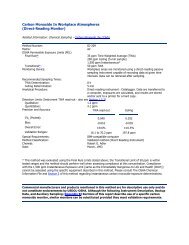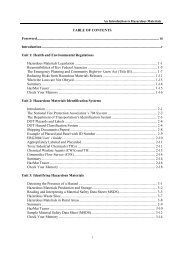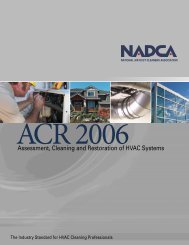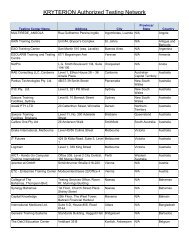Dampness and Mould - WHO guidelines for indoor air quality - PRWeb
Dampness and Mould - WHO guidelines for indoor air quality - PRWeb
Dampness and Mould - WHO guidelines for indoor air quality - PRWeb
Create successful ePaper yourself
Turn your PDF publications into a flip-book with our unique Google optimized e-Paper software.
98<br />
<strong>WHO</strong> GUIDELINES FOR INDOOR AIR QUALITY: DAMPNESS AND MOULD<br />
Ando M et al. (1991). Japanese summer-type hypersensitivity pneumonitis. Geographic<br />
distribution, home environment, <strong>and</strong> clinical characteristics of 621<br />
cases. American Review of Respiratory Diseases, 144:765–769.<br />
Ando M et al. (1995) Summer-type hypersensitivity pneumonitis. Internal Medicine,<br />
34:707–712.<br />
Andriessen JW, Brunekreef B, Roemer W (1998). Home dampness <strong>and</strong> respiratory<br />
health status in European children. Clinical <strong>and</strong> Experimental Allergy,<br />
28:1191–1200.<br />
Arlian LG (1992). Water balance <strong>and</strong> humidity requirements of house dust mites.<br />
Experimental <strong>and</strong> Applied Acarology, 16:15–35.<br />
Arundel AV et al. (1986). Indirect health effects of relative humidity in <strong>indoor</strong><br />
environments. Environmental Health Perspectives, 65:351–361.<br />
ASHRAE (2007a). ANSI/ASHRAE st<strong>and</strong>ard 62.1-2007: Ventilation <strong>for</strong> acceptable<br />
<strong>indoor</strong> <strong>air</strong> <strong>quality</strong>. Atlanta, American Society of Heating Refrigerating <strong>and</strong> Air<br />
Conditioning Engineers.<br />
ASHRAE (2007b). ANSI/ASHRAE st<strong>and</strong>ard 62.2-2007: Ventilation <strong>and</strong> acceptable<br />
<strong>indoor</strong> <strong>air</strong> <strong>quality</strong> in low-rise residential buildings. Atlanta, American Society<br />
of Heating Refrigerating <strong>and</strong> Air Conditioning Engineers.<br />
Austin JB, Russell G (1997). Wheeze, cough, atopy, <strong>and</strong> <strong>indoor</strong> environment in<br />
the Scottish Highl<strong>and</strong>s. Archives of Disease in Childhood, 76:22–26.<br />
Autrup JL et al. (1991). Determination of exposure to aflatoxins among Danish<br />
workers in animal-feed production through the analysis of aflatoxin B1<br />
adducts to serum albumin. Sc<strong>and</strong>inavian Journal of Work, Environment <strong>and</strong><br />
Health, 17, 436–440.<br />
Backman E et al. (2000). The effect of <strong>air</strong> leakage through the moisture damaged<br />
structures in a school building having mechanical exhaust ventilation.<br />
In: Proceedings of Healthy Buildings 2000. Vol.3. Espoo, Sisällmastoseminaarit<br />
:141–146.<br />
Baker D, Henderson J (1999). Differences between infants <strong>and</strong> adults in the social<br />
aetiology of wheeze. The ALSPAC Study Team. Avon Longitudinal Study<br />
of Pregnancy <strong>and</strong> Childhood. Journal of Epidemiology <strong>and</strong> Community Health<br />
53:636–642.<br />
Bakke JV et al. (2007). Pet keeping <strong>and</strong> dampness in the dwelling: associations<br />
with <strong>air</strong>way infections, symptoms, <strong>and</strong> physiological signs from the ocular<br />
<strong>and</strong> nasal mucosa. Indoor Air, 17:60–69.<br />
Bang FB (1956). A bacterial disease of Limulus polyphemus. Bulletin of the John<br />
Hopkins Hospital, 98:325–350.<br />
Barnes C et al. (2006). Comparison of enzyme immunoassay-based assays <strong>for</strong><br />
environmental Alternaria alternata. Annals of Allergy, Asthma <strong>and</strong> Immunology,<br />
97:350–356.






